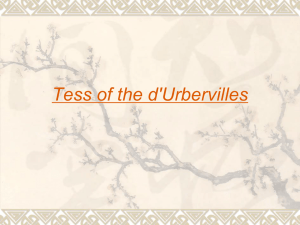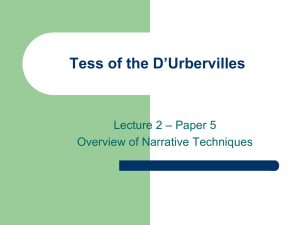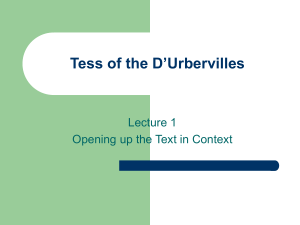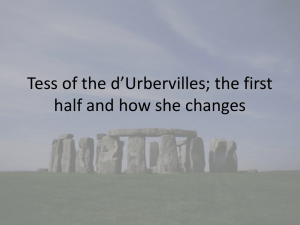File tess of the d`urbervilles frame doc
advertisement
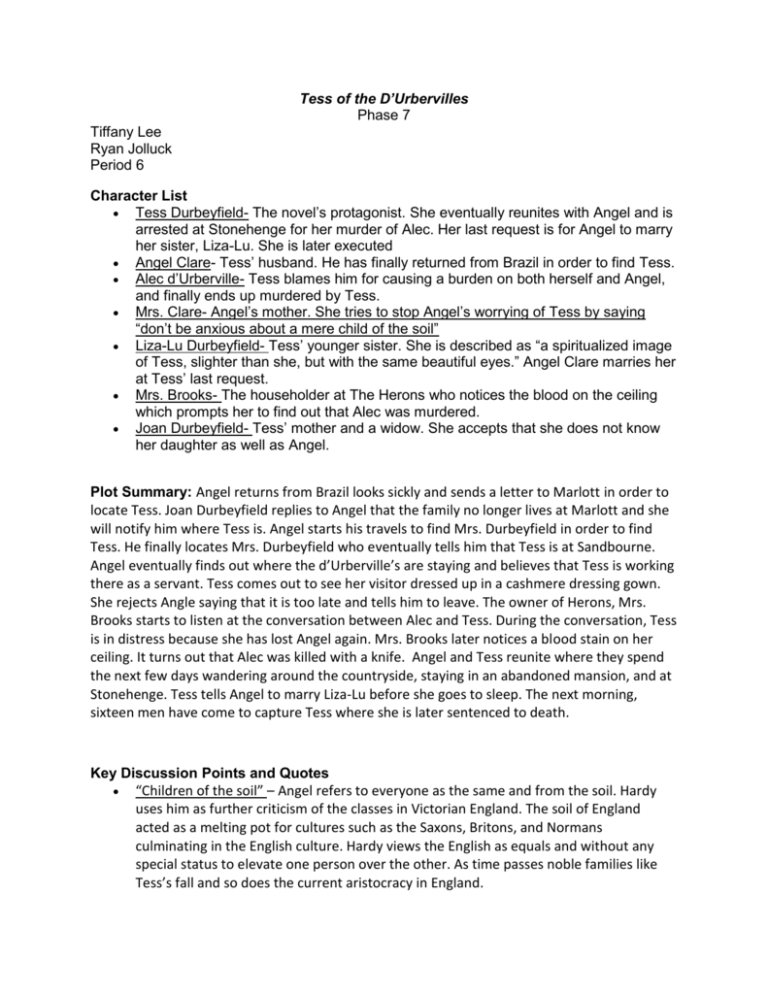
Tess of the D’Urbervilles Phase 7 Tiffany Lee Ryan Jolluck Period 6 Character List Tess Durbeyfield- The novel’s protagonist. She eventually reunites with Angel and is arrested at Stonehenge for her murder of Alec. Her last request is for Angel to marry her sister, Liza-Lu. She is later executed Angel Clare- Tess’ husband. He has finally returned from Brazil in order to find Tess. Alec d’Urberville- Tess blames him for causing a burden on both herself and Angel, and finally ends up murdered by Tess. Mrs. Clare- Angel’s mother. She tries to stop Angel’s worrying of Tess by saying “don’t be anxious about a mere child of the soil” Liza-Lu Durbeyfield- Tess’ younger sister. She is described as “a spiritualized image of Tess, slighter than she, but with the same beautiful eyes.” Angel Clare marries her at Tess’ last request. Mrs. Brooks- The householder at The Herons who notices the blood on the ceiling which prompts her to find out that Alec was murdered. Joan Durbeyfield- Tess’ mother and a widow. She accepts that she does not know her daughter as well as Angel. Plot Summary: Angel returns from Brazil looks sickly and sends a letter to Marlott in order to locate Tess. Joan Durbeyfield replies to Angel that the family no longer lives at Marlott and she will notify him where Tess is. Angel starts his travels to find Mrs. Durbeyfield in order to find Tess. He finally locates Mrs. Durbeyfield who eventually tells him that Tess is at Sandbourne. Angel eventually finds out where the d’Urberville’s are staying and believes that Tess is working there as a servant. Tess comes out to see her visitor dressed up in a cashmere dressing gown. She rejects Angle saying that it is too late and tells him to leave. The owner of Herons, Mrs. Brooks starts to listen at the conversation between Alec and Tess. During the conversation, Tess is in distress because she has lost Angel again. Mrs. Brooks later notices a blood stain on her ceiling. It turns out that Alec was killed with a knife. Angel and Tess reunite where they spend the next few days wandering around the countryside, staying in an abandoned mansion, and at Stonehenge. Tess tells Angel to marry Liza-Lu before she goes to sleep. The next morning, sixteen men have come to capture Tess where she is later sentenced to death. Key Discussion Points and Quotes “Children of the soil” – Angel refers to everyone as the same and from the soil. Hardy uses him as further criticism of the classes in Victorian England. The soil of England acted as a melting pot for cultures such as the Saxons, Britons, and Normans culminating in the English culture. Hardy views the English as equals and without any special status to elevate one person over the other. As time passes noble families like Tess’s fall and so does the current aristocracy in England. How does the soil symbolize England and its history and society? “Children of the soil! Well we all are children of the soil. I wish she were so in the sense you mean: but let me now explain to you what I have never explained before, that her father is a descendant in the male line of one of the oldest Norman houses, like a good many others who lead obscure agricultural lives in our villages, and are dubbed ‘sons of the soil.’” Tess’ loss of self- When Tess meets Angel at the Heron, “she was loosely wrapped in a cashmere dressing-gown of gray-white, embroidered in half-mourning tints, and she wore slippers of the same hue. Her neck rose out of a frill of down, and her wellremembered cable of dark-brown hair was partially coiled up in a mass at the back of her head and partly hanging on her shoulder—the evident result of haste.” This is completely different than what Angel imagined Tess would be doing at Heron. This scene represents how Alec is controlling Tess by making Tess loose herself. The change in clothes makes Tess fit into the role of a proper mistress or someone of upper class. Therefore, is Hardy commenting on how women in upper class are subjected to men? Is there a way for a woman to be free? Tess murdering Alec- Hardy’s narrator focus in chapter 56 shifts to Mrs. Brooks, the householder, in order to provide suspense of the result of Tess’ rejection of Angel. Hardy does not reveal what happens until the workman says “My good God, the gentleman in bed is dead! I think he has been hurt with a knife—a lot of blood had run down upon the floor!” The act committed by Tess represents how she has freed herself from her oppressor in order to come back to Angel. Is Hardy using this event to show that women are only free when they are no longer oppressed by males? Is Tess fated to have this tragedy? “Angel,” she said, as if waiting for this, “do you know what I have been running after you for? To tell you that I have killed him!” “He has come between us and ruined us, and now he can never do it any more. I never loved him at all, Angel, as I loved you.” Stonehenge, Paganism, and sacrifice – Hardy seems to refer to former times of England, before William the Conqueror and spread of Christianity. During these ages in Briton, there was less of a stake in your family name and life was based more on your abilities and merit. Hardy use of the pagan religion can be a part of the writing period of romanticism. Druidism and nature was a large part of paganism and it links to the Romantic Movement. Stonehenge is a possible altar for sacrifices by those who built it. Tess does seem to sacrifice herself for the loving connection with Angel. What represents Tess’ final embodiment of nature? How does Tess’ sacrifice on the altar represent the sacrifice of nature? What does her sacrifice mean about nature? “The heathen temple, you mean?” “But Tess, really tired by this time, flung herself upon an oblong slab that lay close at hand, and was sheltered from the wind by a pillar.” The Justice of Fate- Hardy refers to Tess’ death as ““Justice" was done, and the President of the Immortals, in Aeschylean phrase, had ended his sport with Tess.” This represents how fate is unjust because Aeschylus wrote Prometheus Bound which is used to represent how Tess’ death and suffering was unfair like the punishment that Prometheus receives. This reinforces the idea that Tess’ fate was predetermined since “the d'Urberville knights and dames slept on in their tombs unknowing.” Is fate considered fair? Why is ‘Justice’ in its own quotes? How are the Mighty Fallen- Sir John Durbeyfield’s tombstone’s inscription says “How are the mighty fallen” represents the social criticism of people trying to strive to live from the pride of their ancestors. Hardy’s commentary comes from Mr. Durbeyfield who represents the blend in social classes as he has noble blood but lives as a peasant. Mr. Durbeyfield’s resting place being separated from his ancestors shows that society does not believe that Mr. Durbeyfield belongs there since he has no money, which is seen as a sign of power. Is John Durbeyfield the embodiment of the phrase? "Ah, sir, now that's a man who didn't want to lie here, but wished to be carried to Kingsbere, where his ancestors be." "And why didn't they respect his wish?" "Oh— no money. Bless your soul, sir, why—there, I wouldn't wish to say it everywhere, but—even this headstone, for all the flourish wrote upon en, is not paid for." Symbols Black Flag- It represents Tess’ execution along with the impurity that she had faced in her life. It also shows how Tess’ suffering ended. Stonehenge- This is where Tess recognizes that she must accept her fate for the murder of Alec by “self-sacrificing” herself so that she can end her suffering. Durbeyfield and d’Urbervilles- The name D’Urbervilles in England speaks of a former time when kings ruled and conquered. The French Normans are almost nonexistent and have blended into the English culture. The loss of lands and prestige of the D’Urbervilles symbolizes how family names should have little meaning in modern society. The generations of D’Urbervilles did not live up to the abilities of their fathers leading them into obscurity. Such is the case with most if the aristocratic families in England who are only contributing to society by name and living off the wealth of their inheritance. The Blood Stain on the Ceiling- The blood stain represents Tess killing Alec to win back Angel’s love. It also represents how Tess was able to free herself from her male bondage, which is Alec. Strong Imagery “This fashionable watering-place, with its eastern and its western stations, its piers, its groves of pines, its promenades, and its covered gardens, was, to Angel Clare, like a fairy place suddenly created by the stroke of a wand, and allowed to get a little dusty. An outlying eastern tract of the enormous Egdon Waste was close at hand, yet on the very verge of that tawny piece of antiquity such a glittering novelty as this pleasure city had chosen to spring up. Within the space of a mile from its outskirts every irregularity of the soil was prehistoric, every channel an undisturbed British trackway; not a sod having been turned there since the days of the Caesars. Yet the exotic had grown here, suddenly as the prophet's gourd; and had drawn hither Tess.”-Chapter 55. This is the scene where Angel goes to Sandbourne in order to find Tess. Angel first thinks that Tess is working as a servant. Hardy shows the contrast in the expectation that Angel has of Tess to show that Tess lost herself to Alec who is controlling her. This shows that Tess is not free with Alec. “The next pillar was isolated; others composed a trilithon; others were prostrate, their flanks forming a causeway wide enough for a carriage and it was soon obvious that they made up a forest of monoliths grouped upon the grassy expanse of the plain.”- Chapter 58. This is the description of the Stonehenge. It has a sense of mystery since the scene moves away from a plain field to the pillars of stone. This also lets Tess to become the human sacrifice which is related back to the Pagan traditions. “Against these far stretches of country rose, in front of the other city edifices, a large red-brick building, with level gray roofs, and rows of short barred windows bespeaking captivity, the whole contrasting greatly by its formalism with the quaint irregularities of the Gothic erections. It was somewhat disguised from the road in passing it by yews and evergreen oaks, but it was visible enough up here. The wicket from which the pair had lately emerged was in the wall of this structure. From the middle of the building an ugly flat-topped octagonal tower ascended against the east horizon, and viewed from this spot, on its shady side and against the light, it seemed the one blot on the city's beauty.”- Chapter 59. This is a description of where Tess is executed for her crime. This contrasts with the nature and modern society since Tess was most happy when she was in the countryside away from civilization. This has also allowed Tess’ suffering to end which makes her death be part of the happy ending. Motifs D’Urberville Coach- the motif represents how fate forces Tess to murder Alec because it is in her blood. Therefore, Tess’ execution was predestined since she was destined to commit the crime like her ancestors. “There momentarily flashed through his mind that the family tradition of the coach and murder might have arisen because the d'Urbervilles had been known to do these things.” Durbeyfield name of Tess’s branch of the family is used to imply a family of commoners and peasants working the “fields” instead of a city or town which is what “ville” is more associated with. Traveling – Angel and Tess are often separated and even by the end of the story they are to end up without each other. Both Angel and Tess are moved great distances to find or escape from something or someone. Passages demonstrating Romanticism and/or Realism “Upon the cornice of the tower a tall staff was fixed. Their eyes were riveted on it. A few minutes after the hour had struck something moved slowly up the staff, and extended itself upon the breeze. It was a black flag.”- Chapter 59. This passage represents realism because the narrator is describing a tangible building and a pole that is seen often in the real world. The rising of the black flag is also a procedure that happens when someone gets executed. The sentences are in simple sentence structure. “She ceased, and he fell into thought. In the far northeast sky he could see between the pillars a level streak of light. The uniform concavity of black cloud was lifting bodily like the lid of a pot, letting in at the earth’s edge the coming day, against which the powering monoliths and Trinitrons began to be blackly defined. “Did they sacrifice to God here” asked she. “No,” said he. “Who to?” “I believe to the sun. That lofty stone set away by itself is in the direction of the sun, which will presently rise behind it.” – Hardy demonstrates his uses of mysticism in his work as part of the Romantic movement. The passage shows paganism and a focus on nature. “Have they come for me?” “Yes dearest,” he said. “They have come.” “it is as it should be,” she murmured. “Angel, I am almost glad – yes, glad! This happiness could not have lasted. It was too much. I have had enough; and now I shall not live for you to despise me!” She stood up, shook herself, and went forward, neither of the men having moved. “I am ready,” she said quietly. – This scene also demonstrates the use of Romanticism. Hardy focuses on plot since it is Tess’ arrest that pushes the plot to make a reference to her execution. It also shows a positive outlook since Tess is looking to the positive aspect of her arrest which is being able to still have Angel’s love.


